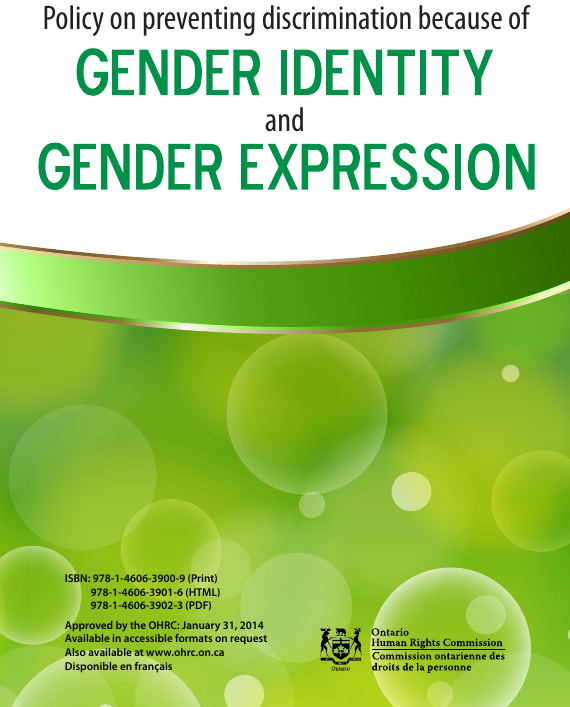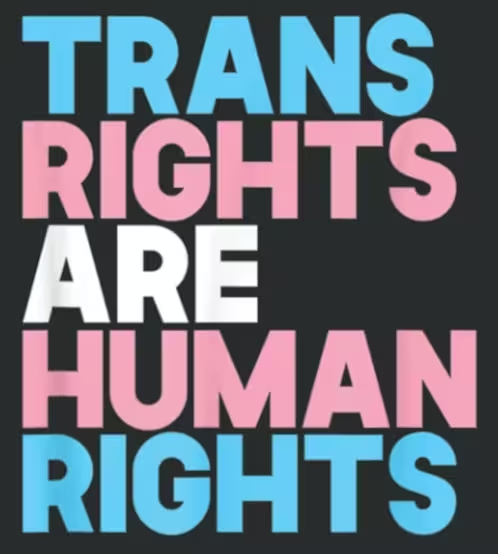The Ontario Human Rights Commission has put together a excellent policy guidebook a number of years ago.

I wanted to share some passages from it which I feel will help illustrate most of what I discuss on this site on the topic of transgender human rights law.
First, it provides some definitions:
Discrimination happens when a person experiences negative treatment or impact, intentional or not, because of their gender identity or gender expression. It can be direct and obvious or subtle and hidden, but harmful just the same. It can also happen on a bigger systemic level such as organizational rules or policies that look neutral but end up excluding trans people. Friends, family or others who face discrimination because of their association with a trans person are also protected.
Harassment is a form of discrimination. It can include sexually explicit or other inappropriate comments, questions, jokes, name-calling, images, email and social media, transphobic, homophobic or other bullying, sexual advances, touching and other unwelcome and ongoing behaviour that insults, demeans, harms or threatens a person in some way. Assault or other violent behaviour is also a criminal matter. Trans people and other persons can experience harassing behaviour because of their gender identity or expression (gender-based harassment) and/or their sex (sexual harassment).
”Transphobia” is the aversion to, fear or hatred of trans people and communities. Like other prejudices, it is based on stereotypes that are used to justify discrimination, harassment and violence toward trans people.
This is great to have because it clarifies the law for you. These are the kinds of things that are illegal under the Human Rights Code, R.S.O. 1990, c. H.19 (which I’ll just call the Code). This isn’t a complete list but it does provide a good idea on what kinds of things are covered by the Code.
This is what the law actually says:
Services 1 Every person has a right to equal treatment with respect to services, goods and facilities, without discrimination because of race, ancestry, place of origin, colour, ethnic origin, citizenship, creed, sex, sexual orientation, gender identity, gender expression, age, marital status, family status or disability. R.S.O. 1990, c. H.19, s. 1; 1999, c. 6, s. 28 (1); 2001, c. 32, s. 27 (1); 2005, c. 5, s. 32 (1); 2012, c. 7, s. 1.
This is just part of the law that deals with services, and there are a number of sections in the Code for the other protected social areas such as Employment.
When receiving goods, services and using facilities (section 1). “Services” is a broad category and can include privately or publicly owned or operated services including insurance, schools, restaurants, policing, health care, shopping malls, etc.
That’s another thing about services. It is quite a broad category.
Organizations are liable for any discrimination and harassment that happens. They are also liable for not accommodating a trans person’s needs unless it would cause undue hardship. They must deal with complaints, take steps to prevent problems and provide a safe, welcoming environment for trans people.
This is the kind of stuff that a Code of Coduct is desiged to protect an organization against. If Facebook’s Community Standards was compliant with Section 1 of the Code, it wouldn’t be such a cesspool.
And finally some specifics from the guide:
Gender-based harassment can involve:
- Derogatory language toward trans people or trans communities
- Insults, comments that ridicule, humiliate or demean people because of their gender identity or expression
- Behaviour that “polices and or reinforces traditional heterosexual gender norms”
- Refusing to refer to a person by their self-identified name and proper personal pronoun
- Comments or conduct relating to a perception that a person is not conforming with gender-role stereotypes
- Jokes related to a person’s gender identity or expression including those circulated in writing or by email or social media46
- Spreading rumours about a person’s gender identity or expression including through the Internet
- “Outing” or threatening to “out” someone as trans
- Intrusive comments, questions or insults about a person’s body, physical characteristics, gender-related medical procedures, clothing, mannerisms, or other forms of gender expression
- Other threats, unwelcome touching, violence and physical assault.
Sexual harassment can involve:
- Intrusive or offensive questions or comments about a trans person’s sex characteristics, sexual identity, romantic relationships or sexual activity, or sexual orientation
- Jokes that objectify a trans or gender non-conforming person in a sexual way including those circulated by email or social media

If you run a business with a connection to Ontario, it is probably a good idea to familiarize yourself with the policy and the Code. You might be thinking you are immune but it is worth discussing the issue with a lawyer. It is entirely possible your country has a treaty to mutually enforce court judgements with mine.
I am happy to see when I see organizations adopt rules that would make them compliant with the Code.
It is also worth noting that anything online is considered telecommunications, which falls under the Canadian Human Rights Act.
Check out the sources and you’ll see why transphobia is a lot more serious. Bigots will downplay a lot of it and use stereotypes as a crutch.